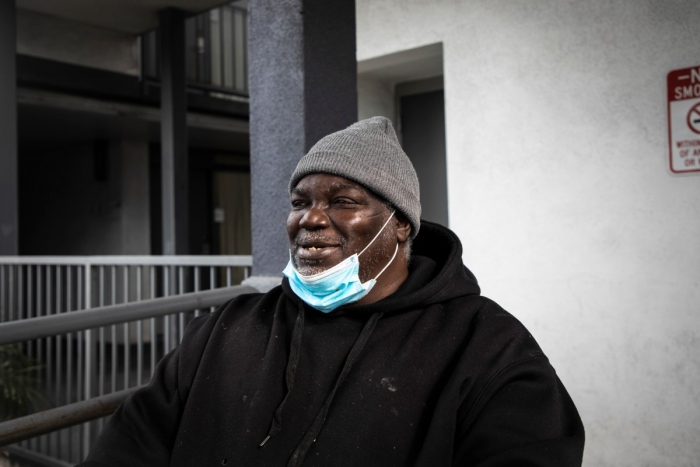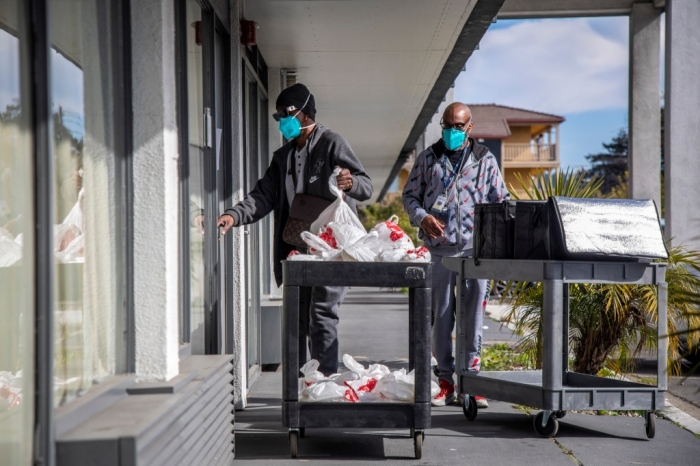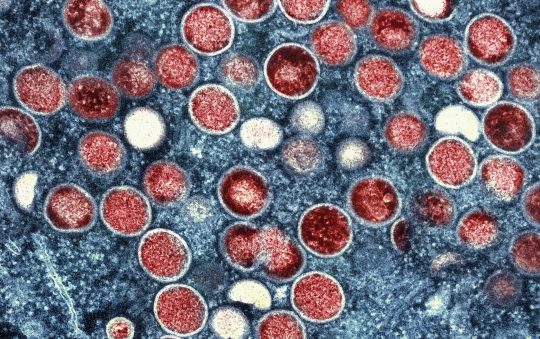
At 66, Edward El has a new lease on life — literally. In two weeks, he’ll move into his own apartment in Berkeley after spending the better part of the past 16 years homeless.
Years ago, a back injury and pinched nerves in his legs made standing and walking painful, and he was laid off from his construction job. He ended up in “shelter after shelter after shelter.”
But nine months ago, El moved into one of 12 Project Roomkey shelters in Alameda County designed to reduce COVID-19 among the homeless population. He was connected with a housing navigator, a counselor and medical staff. They helped El apply for affordable housing and rental assistance vouchers, and coordinated with landlords who would give homeless renters a chance. Now he’ll pay a fraction of the cost to live in an area where one-bedroom apartments often exceed $3,000 per month.
The team also made sure that El was enrolled in Medi-Cal and had transportation to his doctor’s appointments. He said he couldn’t have navigated the array of complex systems if it weren’t for his new case management team.

“I’m happy. They knew about programs that I didn’t know about that allowed me to get a place,” he said.
Intensive case management like this is an example of the ambitious, sweeping changes California made to Medi-Cal beginning in January under an initiative it’s calling CalAIM, or California Advancing and Innovating Medi-Cal.
Medi-Cal offers medical insurance to low-income Californians, serving as a lifeline for nearly half of the state’s children, one in five adults and 2 million seniors and people with disabilities. But the program is inefficient: More than half of Medi-Cal’s roughly $133 billion annual budget is spent on just 5% of the program’s highest-needs individuals — people with multiple complex health problems compounded by homelessness, poverty, substance abuse, mental illness or incarceration, according the Department of Health Care Services.
Over the next five years, the goal of CalAIM is to address the upstream drivers of deteriorating health — things like food insecurity and housing instability — in an effort to reduce costly emergency department visits, hospitalizations and nursing home stays. The program redesign is based on “whole person care” principles, which help people avoid situations that worsen their physical and mental health.
“This was designed at the county level to identify very high risk populations — oftentimes people who were coming to the emergency room five to 10 times a month.” said Erica Murray, president and CEO of the California Association of Public Hospitals and Health Systems.
In his January budget, Gov. Gavin Newsom proposed $8 billion over five years to implement the program, about 6% of Medi-Cal’s total budget. Included are temporary payments to managed care plans to offer enhanced case management and other services.
These so-called social determinants of health have not been historically covered by health insurance like Medi-Cal. Yet they have an outsized impact on people who often struggle with economic instability, poor nutrition, discrimination, violence and disproportionate exposure to polluted air and water.
“One of my patients calls it social deterrents to health,” said Alameda County Medical Director Dr. Kathleen Clanon.
No other state has mounted such a comprehensive program that wraps in so many elements. The scale is unprecedented, too: Medi-Cal provides health insurance for more than 13 million people.
“This is a big deal. Not only is California taking the lead but also setting a precedent for potentially other states to follow it,” said Anthony Wright, executive director of Health Access California, a consumer advocate group.
Pilot programs in 25 counties helped get CalAIM off the ground. Roughly 108,000 Medi-Cal patients were enrolled in county pilots and 15,000 in managed care pilots during a two-year period, according to an early analysis by UCLA researchers. As a result of the success, federal officials granted a waiver allowing CalAIM to move forward for the next five years.
In Placer County, David Norris, 67, was one of the patients who benefited from the experimental programs.
Norris ended up in a homeless shelter after his mother, whom he was a long-term caregiver for, died. He earns $900 a month in Social Security and retirement, but it’s not enough for rent and living expenses.
In April, an infected foot wound spread to the bone and cost Norris his left leg. Another infection resulted in more trips to the ER and subsequent surgeries. Several months later, a fight at the shelter ended in a shove, a fall and a broken right leg.
His caseworker, Todd Perbetsky, helped him enroll in Medi-Cal, find a nursing home to recuperate in and apply for a housing voucher. He’s now helping Norris find permanent housing after leaving the nursing home.
“These are definitely people that are falling through the cracks,” Perbetsky said. “They may not meet the criteria of some programs. They may need linkage to services. They can have tons of barriers to even getting their CalFresh turned on or other benefits they qualify for.”
Norris called Perbetsky a “hell of a godsend. If you don’t know the ins and outs, you just get spit out. You get absolutely no help at all. That’s where Todd…helps me and people like me navigate the waters and get all squared away.”
A Byzantine system
Wraparound services aren’t new, but they haven’t always been easy to access nor have they been directly connected to medical care. Walk through the wrong door and you might not get any help at all.
A homeless patient who suffers from addiction and mental health issues and has diabetes would have to approach three different county departments and a doctor in order to get all of their needs addressed, and even then they’re likely to get lost in the system.
“It’s a little bit like if you needed to get ingredients for a meal and instead of just going to the supermarket, you had to go to different stores to get your proteins and your fruits and your grains and your vegetables. And at those stores, you had to pay with different cards and navigate different rules about what you could buy,” said Melora Simon, a senior strategist at the California Health Care Foundation.
This fragmentation frequently causes barriers to health care and is one of the primary reasons the Department of Health Care Services is focused on reforming Medi-Cal under CalAIM.
One such barrier is making sure patients don’t get lost between systems that don’t traditionally talk to one another.
Clanon, who also works as a physician in Alameda County, said a few years ago a pregnant, HIV-positive patient needed to begin HIV treatment but had left the usual encampment she stayed in and couldn’t be found. A nurse spent more than an hour calling local emergency departments, homeless shelters and case managers to see if anyone had seen the patient, with no luck.
Had the system been integrated, Clanon’s patient would have been flagged as needing critical medical care any time she entered a homeless shelter, emergency department, substance abuse center or mental health facility.
“CalAIM is trying to fix the problem of disparate systems of care both among and between different counties and among and between different parts of the healthcare system,” said Diana Douglas, a health policy expert with Health Access California.
Accountability and missing pieces
Since 2016, California has dedicated more than $3 billion in state and federal funds to experiment with doing just that.
Four years after launch, the pilots demonstrated “substantial evidence” of improved follow-up after hospitalization for mental illness, increased participation in substance abuse treatment and decreased use of emergency services, among other metrics, according to the UCLA analysis.
In Contra Costa County, more than 12,000 patients were enrolled in the pilot annually, and the county health department hired more than 100 public health nurses, mental health specialists, community health workers, homeless service specialists, substance abuse specialists and social workers to provide coordinated case management.
“Most of them were types of positions that existed in the county before, but they were very siloed,” said Emily Parmenter, the pilot’s program manager at Contra Costa County Health Services. “So we brought them all together in these multidisciplinary teams where they had a wealth of experience…and were able to provide case consultations across divisions.”
Medi-Cal patients who enrolled in the Contra Costa pilot experienced medical emergencies less frequently than non-enrolled patients.
“We found that after being involved in the program for a year, our hospital admission rates decreased by 25%…and our (emergency department) rates were 14% lower compared to the control group,” Parmenter said.
UCLA researcher Nadereh Pourat, who conducted the pilot evaluation, said her team has just begun to analyze the impact on specific health conditions, such as blood pressure and congestive heart failure, as well as cost-effectiveness.
Despite their promise — or perhaps because of it — advocates say the transition from pilot programs to CalAIM will need to be watched carefully.
Responsibility has now shifted from county health departments to health care plans, which don’t always meet quality benchmarks. And health plans in the 33 counties that did not have pilots are starting from scratch.
“There are serious concerns about Medi-Cal (health care) plans on the ground being able to implement some of the work necessary for CalAIM to really be effective and live up to its potential,” health policy expert Douglas said.
“In some cases, plans struggle to deliver quality care across what we think of as very basic measures: childhood immunizations, are people getting mammograms on time, just very basic preventive care and chronic disease management.”
Accountability is especially important for improving equity among minorities, advocates say.
“Communities of color are disproportionately impacted by these same factors: lack of housing, lack of income, lack of food security,” said Cary Sanders, senior policy director for the California Pan-Ethnic
Health Network.
Health plans need to provide services that are “linguistically and culturally appropriate,” Sanders said.
One critical piece of the pilot programs that was left out of CalAIM is legal aid. In counties that funded legal aid during the pilot programs, lawyers and paralegals were stationed in medical clinics to assist patients who needed help with benefit denials, eviction notices, immigration issues, or domestic abuse cases.
Frequently patients and even their doctors don’t realize that their issue could use the help of a lawyer, said Daniel Nesbit, managing attorney for medical legal partnerships with California Rural Legal Assistance. Nesbit said during the pilot program in Monterey County his team helped 700 clients with more than 1,000 cases.
“A really good example is someone struggling with some sort of medical condition, and it’s making it hard for them to go to work every day and do their job to the full extent,” Nesbit said. “They might not know, for example, that they have a possible right to a reasonable accommodation under the Americans with Disabilities Act.”
Alameda and Contra Costa counties, which contracted with Bay Area Legal Aid to participate in the pilot, hired five additional attorneys dedicated to assisting Medi-Cal patients. The partnership helped reach people who ordinarily wouldn’t be able to access legal aid because their disability prevented them from attending an appointment or they didn’t have a phone number or address. Case managers were able to link people to the attorneys, accounting for 300 referrals a year.
But when the pilot ended in December and state funding dried up, attorneys were reassigned and are no longer able to focus on Medi-Cal patients.
“I’m still getting emails and phone calls from the case managers I worked with who I think are now kind of scrambling to figure out how to help,” said Abby Khodayari, an attorney who worked in Contra Costa County’s program. “Case managers are hoping to get help analyzing eviction notices and figuring out the validity of them. It’s hard not having dedicated time to be able to spend working on those issues.”
While legal services aren’t explicitly named as one of 14 pre-approved services under CalAIM, the Department of Health Care Services said health plans could integrate them as part of supportive housing services, which are covered.
But attorneys say it’s unlikely to happen unless plans get specific guarantees that CalAIM will cover the cost. They hope that subsequent phases of CalAIM will include legal aid.
“There hasn’t been a health plan here in LA who’s come forward and said we want to offer these legal services,” said Gerson Sorto, a managing attorney with Neighborhood Legal Services of Los Angeles.
Los Angeles County has continued funding their partnership through the summer, but there’s no permanent money in sight. “As of today, there is no funding secured or confirmed beyond June 30,” Sorto said.
Life under ‘whole person care’
Back at the Radisson Hotel in Oakland, the shelter where El is waiting patiently to move into his new apartment, he watches a home renovation show on the television. He likes to see how the hosts redesign the interior and gets ideas for his own future home.
Before losing his job, El lived in an apartment near Lake Merritt but hasn’t had a place to call his own in years. After he enrolled in Alameda County’s pilot program, things started turning around for him.
“These people really respect you and help if you ask for it,” El said.
Part of the program is connecting Medi-Cal patients to peers with similar backgrounds.
“You can’t tell them ‘do this and do that.’ You walk alongside someone and support whatever they’ve got going on,” said Michael Webb, a CalAIM peer support navigator who struggled with addiction and homelessness. “Most importantly,” he said, “someone to listen. I might not have any answer at all but there’s power in listening.”
Down the hall from El’s room, shelter monitors are delivering lunch to residents that can’t make it to the dining room. Lunch is a chicken sandwich, banana, salad and a soda, but those with dietary restrictions or certain medical conditions like diabetes get tailored meals.
As part of the CalAIM program, caretakers perform wellness checks on shelter residents with disabilities, helping them clean, bathe and use the restroom.
In the lobby, an intake worker asks a new guest about his seizure disorder and works to link him to his CalAIM team of health care providers, case workers and housing navigators. As the program grows, millions more Californians may benefit. On this day alone, the Oakland team expects to sign up eight new people.







